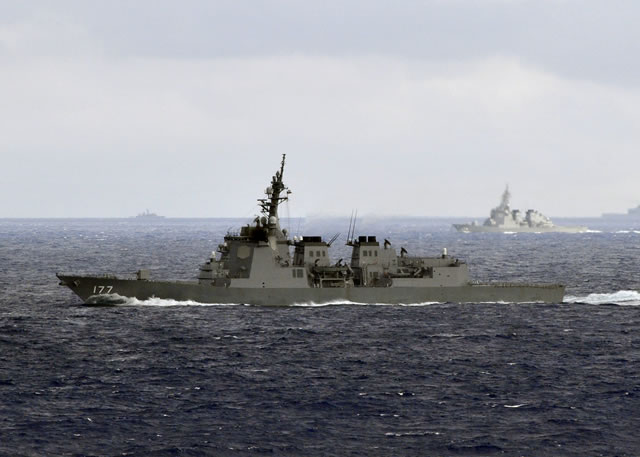Breaking news
Japan MOD to Explore Acquisition of Cooperative Engagement Capability.
By Ben Rimland
The Mainichi Shimbun reports that Japan’s Ministry of Defense (MOD) is in the midst of studying the feasibility of equipping its next-generation Aegis destroyers and E-2D Advanced Hawkeye AWACS with Cooperative Engagement Capability (CEC).
 CEC explained
CEC explained
CEC is a “sensor netting” system that links together detection and tracking sensors of aircraft and ships to provide an “integrated fire control capability” for warships. The system is specifically designed to facilitate allied air defense efforts by transforming AWACS platforms into extensions of an allied surface ship’s own sensor suite.
MOD is currently set to procure four E-2D Advanced Hawkeyes and two new Aegis destroyers in 2019-2020. The Mainichi reports that acquisition of CEC for the two new Aegis vessels is scheduled, while installation of CEC capability for the E-2D is under study. The report further notes that consideration of CEC comes at approximately the two year anniversary of the promulgation of limited collective self defense for the Japanese Self-Defense Forces, capability that came into force a year after the 2015 passage of the national security-related laws.
A CEC capability would allow Japan’s Aegis-equipped destroyers to remain in the rear area of a potential engagement, allowing their missiles to be guided by faster-moving assets closer to the fight. At present, Japan’s Aegis vessels are capable of utilizing only their own radars for guidance and detection of enemy missiles and aircraft. CEC would both expand the detection range of Japan’s Aegis vessels and strengthen interoperability with American assets.
Ben Rimland is an independent researcher on Asia-Pacific security issues. His academic research pertains to Japanese defense policy and American security policy in Asia. He can be found on twitter at @JPNsecuritywonk.
 JMSDF guided-missile destroyer JDS Atago (DDG 177). Picture: US Navy
JMSDF guided-missile destroyer JDS Atago (DDG 177). Picture: US Navy
About CEC
Cooperative Engagement Capability (CEC) is a real-time sensor netting system that enables high quality situational awareness and integrated fire control capability. It is designed to enhance the anti-air warfare (AAW) capability of U.S. Navy ships, U.S. Navy aircraft and U.S. Marine Corps (USMC) Composite Tracking Network (CTN) units by the netting of geographically dispersed sensors to provide a single integrated air picture, thus enabling Integrated Fire Control to destroy increasingly capable threat cruise missiles and aircraft.
About the future JMSDF Aegis vessels
According to the US Defense Security Cooperation Agency, the new class of DDGs will be based upon a modified Atago-class hull. In 2000, the Japan Defense Agency Maritime Staff Office included another two Aegis ships in its five-year budget on top of the four Kongo class destroyers originally ordered. The Atago class is fundamentally an improved and larger version of Kongo class destroyers. The vessels have all of the armament of the Kongo class but received a hangar space for to accomodate two SH-60 helicopters. Atago class destroyers displace 10,000 tons full load. JDS Atego DD178, was commissioned in 2007 and JDS Ashigara DD-178 was commissioned in 2008.
About E-2D Advanced Hawkeye
The E-2D Advanced Hawkeye is the newest variant of the E-2 aircraft platform. It features a new radar and upgraded aircraft systems. The U.S. Navy is set to receive 75 Advanced Hawkeyes by 2027. The IOC was declared in October 2014. The first aircraft carrier deployment took place aboard USS Theodore Roosevelt in March 2015. The E-2D conducted its first flight on August 3, 2007. The Japan Ministry of Defense became the first export customer of the E-2D Advanced Hawkeye in 2014 to fulfill the nation's airborne early warning requirements. Northrop Grumman began production in 2016 on two aircraft. First flight of a JASDF E-2D took place in November last year.

























